
Common name:Boston Ivy
Botanical name:Parthenocissus tricuspidata
This semi-evergreen vine has dark green leaves that are usually lobed and divided into 3 leaflets. Clings with both tendrils and adhesive-like tips that cements itself to all manner of surfaces. Leaves turn orange or red in autumn. Flowers are inconspicuous. During fall, small blue black berries appear to the delight of birds. This vine can grow 50'-60' long but it really depends on what it is growing on. This vine is aggressive.
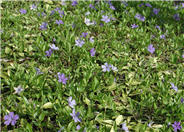
Common name:Dwarf Vinca or Periwinkle
Botanical name:Vinca minor
Periwinkle is a hardy, evergreen groundcover with glossy green leaves and cheery periwinkle blue or purple flowers in the spring. This plant is best suited to large areas and shrub borders, as it would overwhelm most perennials. Avoid its use along the riparian corridor or in urban/open space interfaces as it is aggressive and can escape, overtaking native plants. Easier to control in dry shade areas. Grows about 6 to 8 inches high, and spacing for planting purposes is about 2 to 3 feet, but its spread is indefinite.
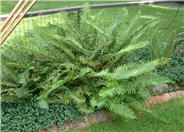
Common name:Western Sword Fern, Alaska Fern
Botanical name:Polystichum munitum
This Fern produces upright fronds, reaching 4'-5' tall in moist, cool forests in Northern California. This size is usually lower, especially without summer watering. It is great in containers or dry shade landscapes. This species is especially useful to give the illusion of lush, moist gardens where little water is actually being used. It should receive part shade to dense shade. -Monterey Bay Nursery
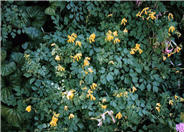
Common name:Yellow Corydalis
Botanical name:Corydalis lutea
Corydalis is a wonderful little perennial with ferny, rounded blue-green leaves that form a rounded, somewhat irregular mound about 12 to 15 inches tall and wide. It blooms sporadically from May until September, in clusters of tubular, spurred, yellow flowers. Nice in dry shade gardens, rock gardens, woodland settings, and any shady nook where a little yellow cheer would be appreciated.
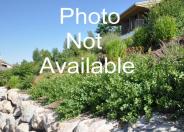
Common name:Rose Daphne
Botanical name:Daphne cneorum
Rose daphne is a slow-growing, mounding, broad-leafed evergreen shrub that reaches about 12 or so inches tall and 12 to 24 inches wide. It has a prostrate habit and is well suited to a rock garden setting. It has oblong leaves that are generally a dark green color, and bright pink, fragrant flowers that bloom in April. There are a number of cultivars selected for variations in flower color, leave variegation, and size.
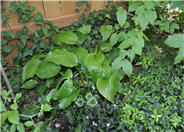
Common name:Hosta
Botanical name:Hosta
Hosta are herbaceous perennials, hardy to Zones 3 or 4, depending on the variety. Sometimes referred to as the plantain lily, hosta have fleshy roots and short spreading rhizomes; in spring broad leaves emerge from a central crown and develop into a mounded form. Leaves come in colors from bright green to gold and even blue tones; some have variegated leaves, with strips, blotches, or margins of varying shades of green, white, cream or gold. Leaf texture varies and can be smooth, veined, or even puckered. Leaf size ranges from petite (a few inches long) to gigantic (a few feet long). Descriptions such as heart-shaped, lance-like, and cupped characterize different leaf shapes. Depending on growing conditions and variety, individual plants range in size from six inches high and a foot or less across to 3 to 4 feet high and 5 to 6 feet across. Although hosta flowers are sometimes discounted as secondary, they can provide great ornamental value. The flower stalks, known as racemes, hold bell-like blossoms of white or lavender to blue. Some flowers are exceptionally fragrant as well as attractive to hummingbirds and bees. Use as an understory plant in the shady shrub or foundation border, or under trees, or in the shady perennial garden.
| Designer: Kelly Pack | Kelly Asian 16 |
Photographer: GardenSoft |
Water Saving Tip:
Even though it's hot, your lawn only needs to be watered twice a week to stay healthy.
And don't water the whole lawn for a brown spot—drag out a hose.
